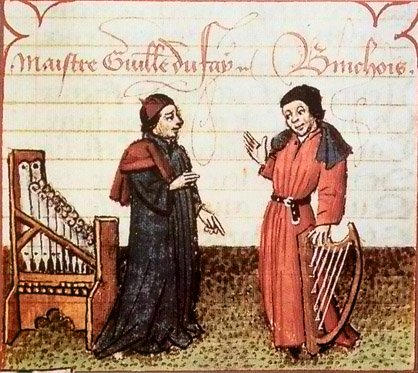Guillaume du Fay
The Renaissance
Master of the Missal of Paul Beye, Public domain, via Wikimedia Commons
Guillaume du Fay's life begins in scandal. He was born near Brussels in 1397 to an unmarried mother; his father was most likely a priest (who had, of course, taken a vow of celibacy.) As a teenager, he studied music at the cathedral in Cambrai, France. He pursued a clerical career, and attended the Council of Constance, which ended the Western Schism, with the Bishop of Cambrai in 1414. After this, du Fay traveled through Italy, eventually coming to Bologna, where he became a priest.
By this point, he was already gaining a reputation as a skilled and innovative composer, and went to Rome in 1428 to work for Pope Martin V, and continued working for Pope Eugene IV after his predecessor's death. His reputation continued to grow throughout Europe and he wrote music for many important occasions, including the dedication of the Duomo of Florence in 1436. The musical structure of this piece is divided into four sections with different meters, creating isorhythmic ratios of 6:4:3:2, the same dimensions as the cathedral (and possibly referencing the dimensions of Solomon's Temple from the Bible.) Du Fay also composed a lament for the Fall of Constantinople after the Turks conquered the city in 1453.

Acediscovery, CC BY 4.0
He continued to compose in various places around Europe, notably in the courts of Savoy and especially Burgundy. His association with the Burgundian court popularized his style throughout Europe. Many among the next generation of composers studied with him, most notably Johannes Ockeghem. Eventually, du Fay returned home to Cambrai, where he passed away in 1474. On his deathbed, the Cambrai Cathedral choir sang one of his motets, with an additional verse he had written, asking God to have mercy on his soul.
Du Fay's style moved beyond the droneless polyphonic techniques of Guillaume de Machaut, greatly expanded Western music's harmonic repertoire with his skilled use of thirds and sixths to form triadic harmonies. This set the standard for the musical techniques of the Renaissance, and arguably down to today.
